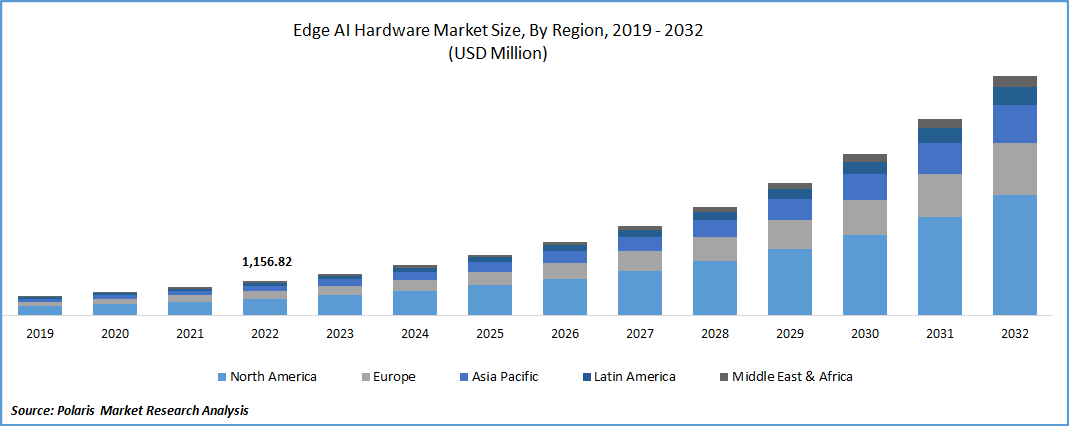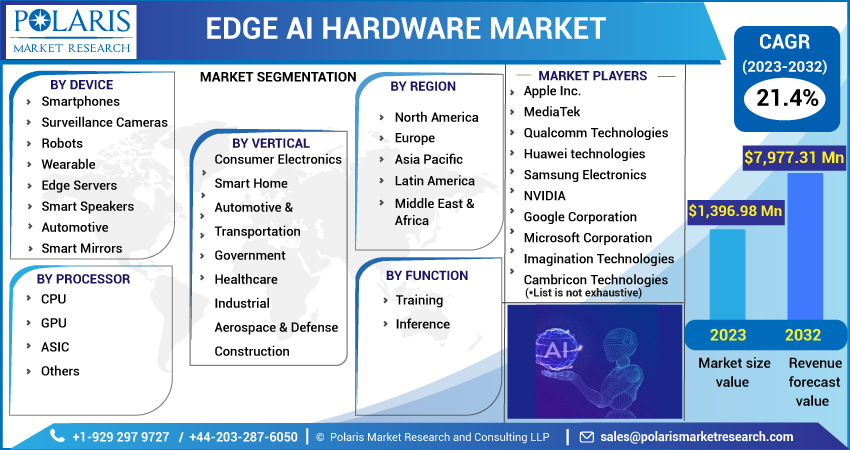
Edge AI Hardware Market Share, Size, Trends, Industry Analysis Report, By Device; By Processor (CPU, GPU, ASIC, Others); By Function; By Vertical; By Region; Segment Forecast, 2023 - 2032
- Published Date:Apr-2023
- Pages: 115
- Format: PDF
- Report ID: PM3121
- Base Year: 2022
- Historical Data: 2019-2021
Report Outlook
The global edge AI hardware market was valued at USD 1,156.82 million in 2022 and is expected to grow at a CAGR of 21.4% during the forecast period. The extensive rise in the demand for low latency and real-time processing on variety of edge devices, increasing workloads of businesses on cloud, and introduction to various intelligent applications in the market are primary factors expected to create demand and growth for the global market. In addition, the AI inference without any need of data transfer and its ability to reduce the business operation costs in various critical case-loads, where accuracy is must has also generated huge demand across edge AI devices.

Know more about this report: Request for sample pages
For instance, in June 2022, Qualcomm Technologies, introduced its comprehensive AI stack portfolio, that improve the company’s new AI-based software offerings. It is an AI solution for both developers & OEMs, supporting large number of intelligent devices with broad AI-based software access & compatibility.
The launch of 5G networks across many countries is bringing the telecommunications and IT together to develop and introduce more advanced features for various high-end premium products and reduce network latency. The proliferation of 5G network allows to establish data centers at edge modules and also implement industry-specific networks. The rapid emergence of 5G networks across different applications is likely to result in increased volume of data transferred to data centers., thereby fueling the demand for edge Ai hardware devices to manage this efficiently.
The outbreak of the COVID-19 pandemic has significantly impacted the growth of the edge AI hardware market. The rapid spread of COVID-19 has had a negative impact and influence on the operations of manufacturing industries, a major slowdown in the global supply chain, increase in the customer concern, and decline in the corporate confidence, which in turn has largely hindered the market expansion.

Know more about this report: Request for sample pages
Industry Dynamics
Growth Drivers
Growing requirement for the low latency and real-time transmission critical-applications across various industries and growing use of these kind of devices to improve the overall processing of artificial intelligence devices through processing the data in the hardware itself, are key factors projected to boost global edge AI hardware market growth over the anticipated period. In edge AI, ML algorithms effectively process the internet generated data to the nearby devices to over-come the issues related to security & high latency.
In addition, the market for edge AI hardware is projected to gain a significant growth in the adoption rate over the coming years owing to the increased security and privacy, as companies want to be more protective and safer towards their sensitive and private data especially form healthcare and consumer sectors. For instance, as per the survey conducted by the “Cloud Security Alliance”, around 200 IT & IT security leaders globally identified that the 73% of respondents registered security & data privacy as their biggest business concern.
Report Segmentation
The market is primarily segmented based on device, function, vertical, and region.
|
By Device |
By Processor |
By Function |
By Vertical |
By Region |
|
|
|
|
|
Know more about this report: Request for sample pages
Smartphones segment accounted for largest market share in 2022
Higher integration of edge AI into variety of new coming smartphones, as it offers several added benefits and capabilities to smartphones in terms of power efficiency, security, and imaging & photography are key factors driving the segment growth. In addition, early adoption of various AI chips or processors and innovated technologies in the image recognition, real-time speech, and voice recognition coupled with the growing penetration and sales of 5G-based smartphones globally are likely to have positive impact on the market over the coming years.
For instance, a report published by Canalys, 5G enabled smartphones is expected to reach around 800 million units by 2023, that accounts for over 51.4% of all smartphone shipments, and passing the 4G smartphones after a launch period of 5 years. Greater China is expected to lead the smartphone shipments with 34% followed by North America at 18.8%.
However, the wearables segment is likely to expand at fastest growth rate during the forecast period, owing to the adoption of smart wearables & the growing number of innovative wearable launches by key market players across the globe. With the deployment of edge AI, wearables are becoming significantly smarter, that results in higher adoption and impact positively in the near future.
Training segment held the significant market revenue share in 2022
The training segment led the global market for edge AI software in 2022, which is mainly accelerated by its gaining significant importance across wide range of industrial applications including manufacturing, IT, BFSI, ecommerce, healthcare, and retail. The influencing need for application-specific training, as it enables machines to learn from the experience, performing human-like tasks, and easy adjustment to new inputs along with its numerous other advantages including process massive data quickly. Thus, the segment is likely to have significant growth over the coming years.
Consumer electronics segment dominated the edge AI software market
The consumer electronics segment dominated the global market in 2022 with a holding of healthy market share, on account of the growing use of artificial intelligence in various consumer electronics applications owing to its innovations like advanced analytics with insights to make better decision-making, autonomous business processes, eliminate the need of manual process, AI-powered immersive, and continuous interfaces.
The automotive & transportation segment is likely to register fastest growth throughout the forecast period, owing to rapid surge in the adoption of new processor cars across several countries like Japan, South Korea, and China coupled with the growing consumer demand for driverless vehicles and autonomous features for their safety and convenience. High prevalence of artificial intelligence technology and several government favorable initiatives, that have mandated to integrate few safety features in the vehicles, in order to reduce the number of accidents on the road, shall drive the segment growth.
The demand is Asia Pacific is expected to witness significant growth
Asia Pacific region is projected to emerge at fastest growth rate during the forecast period, which is mainly driven by continuous rise in the in the penetration for smartphones and robust demand for surveillance cameras because of the tightened control on the internet and digital communication by governments in APAC countries. China is the largest market in the region followed by Japan owing to the presence of prominent vendors in electronics, automobile, and semiconductor companies, who are heavily investing in the AI technology, is driving the market growth in the region.
Furthermore, North America dominated the global market and is projected to maintain its dominance over the study period. High latency due to the network congestion, significant dependency on IoTs, need for faster device processing, and adoption of edge AI in US and Canada are among the primary factors propelling the market growth in the region.
Competitive Insight
Some of the major players operating in the global market include Apple Inc., MediaTek, Qualcomm Technologies, Huawei technologies, Samsung Electronics, NVIDIA, Google Corporation, Microsoft Corporation, Imagination Technologies, Cambricon Technologies, Xilinx Inc., Intel Corporation, Advanced Micro Devices, and IBM Corporation.
Recent Developments
- In May 2022, Intel’s Habana Labs announced the launch of its new second-generation AI deep learning processors for training and inferencing. The newly developed processors come with high performance and high-efficiency deep learning choices across data centers while lowering the entry barriers for new and small size companies.
- In September 2022, OmniML announced about the availability of “Omnimizer”, a platform that simplifies and enhance the ML operations by addressing process gap between ML models & edge hardware. It will allow ML engineers to focus more on the model design and training without any need to be worry about complex details regarding hardware deployment and further eliminates the inefficiencies leading to the slow deployment.
Edge AI Hardware Market Report Scope
|
Report Attributes |
Details |
|
Market size value in 2023 |
USD 1,396.98 million |
|
Revenue forecast in 2032 |
USD 7,977.31 million |
|
CAGR |
21.4% from 2023 – 2032 |
|
Base year |
2022 |
|
Historical data |
2019 – 2021 |
|
Forecast period |
2023 – 2032 |
|
Quantitative units |
Revenue in USD million and CAGR from 2023 to 2032 |
|
Segments covered |
By Device, By Processor, By Vertical, By Region |
|
Regional scope |
North America, Europe, Asia Pacific, Latin America; Middle East & Africa |
|
Key companies |
Apple Inc., MediaTek, Qualcomm Technologies, Huawei technologies, Samsung Electronics, NVIDIA, Google Corporation, Microsoft Corporation, Imagination Technologies, Cambricon Technologies, Xilinx Inc., Intel Corporation, Advanced Micro Devices, and IBM Corporation. |
FAQ's
Key companies in edge AI hardware market are Apple Inc., MediaTek, Qualcomm Technologies, Huawei technologies, Samsung Electronics, NVIDIA, Google Corporation, Microsoft Corporation, Imagination Technologies.
The global edge AI hardware market is expected to grow at a CAGR of 21.4% during the forecast period.
The edge AI hardware market report covering key segments are device, function, vertical, and region.
Key driving factors in edge AI hardware market are Increase in demand for smart homes & smart cities.
The global edge AI software market size is expected to reach USD 7,977.31 million by 2032.
